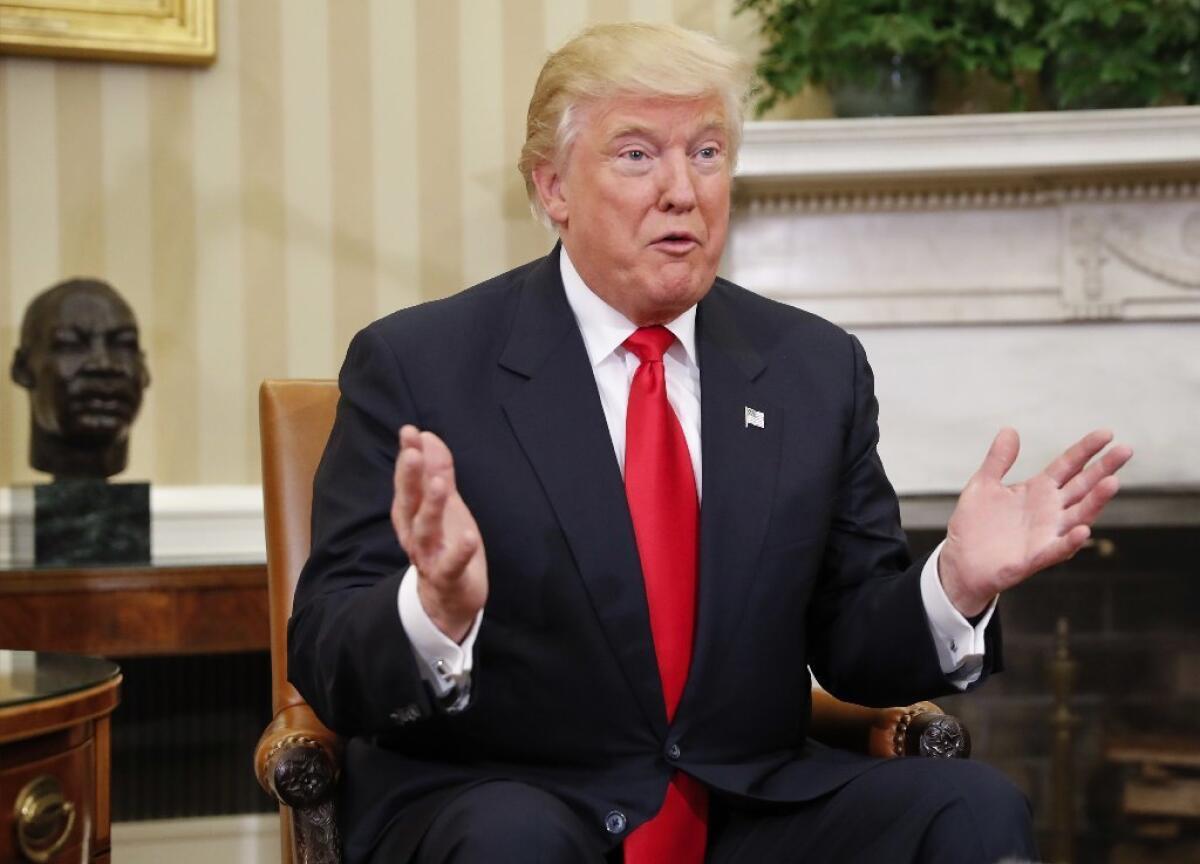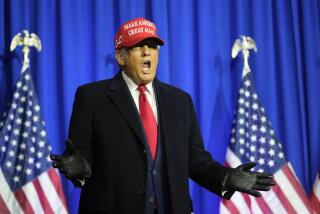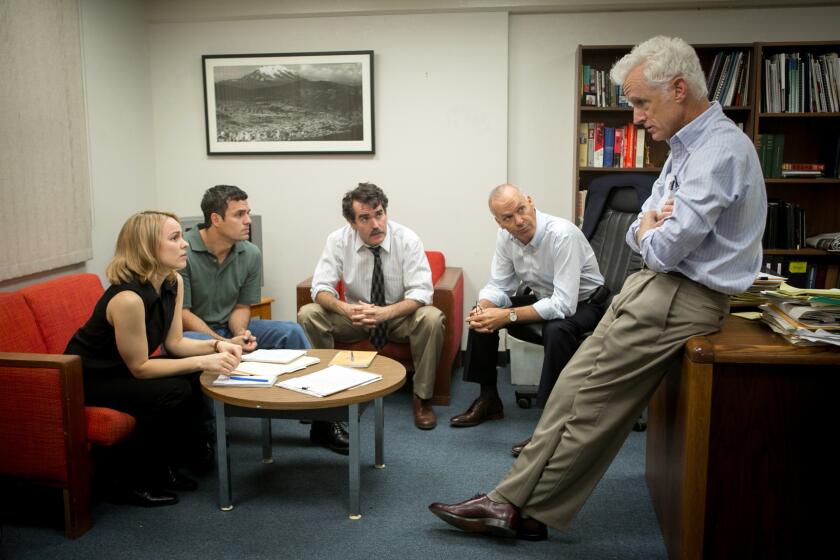Fear of a Trump-triggered recession gives way to hope for short-term economic boost

The populist promises that catapulted Donald Trump into the White House also stoked fears that his policy proposals could severely damage the economy.
Most mainstream economists saw his repeated threats to seal borders and slap massive tariffs on Mexican and Chinese goods as sure-fire prescriptions for trade wars and recession.
Despite such pessimistic pre-election assessments, the early post-election sentiment among businesses and investors appears to be more of hope than fear.
Business leaders are betting that Congress and political realities will temper Trump’s more extreme ideas, and the policies that survive may actually give needed fuel to an economy that many forecasters predicted would face a slow-down over the next four years, regardless of who won the White House.
The question now: How long will that optimism last if the president-elect’s rosy view proves wrong and he’s unable to double the nation’s economic growth as promised?
The U.S. economy is already sluggish and fragile, even as it enjoys one of the longest-ever periods of growth. The economies of almost all the other developed nations aren’t much better and are mostly worse.
To many, a Trump upset on election day was exactly the kind of jolt that they feared would send U.S. and global growth reeling into decline.
“A volatile candidate is likely to be a volatile president,” said Paul Ashworth, chief U.S. economist for Capital Economics.
One reason for a less pessimistic view now is that Trump — in his conciliatory and measured victory speech early Wednesday — vowed to launch a major overhaul of U.S. infrastructure by pouring billions of government dollars into highway and other construction projects.
Such a program would amount to a massive economic stimulus effort as government dollars went first to construction companies, then to thousands of workers and finally ripple out through the whole economy as those workers spent the new dollars on cars, houses, groceries and other consumer goods.
Conservative Republicans in Congress rejected similar overtures from President Obama. But Trump’s surprise victory may give him greater leverage with Congress, particularly since his party controls both House and Senate.
And most Republican lawmakers already support Trump’s call for lower corporate taxes and less government regulation, both of which could provide more economic stimulus, at least in the immediate future.
In matters that might dampen the economy, the betting is that Trump will not be able to move as quickly. On the divisive issue of trade, Trump on Wednesday did not renew his repeated campaign threats to tear up trade deals. Rather, he said he would be a president for all Americans and seek partnerships with the world.
Short of unilaterally withdrawing from NAFTA and other trade agreements, which the president does not have the power to do without consulting Congress, even the most hard-nosed negotiations would take time.
Many remain skeptical, believing that Trump’s deep-seated beliefs — he has been complaining about unfair trade since the 1980s — and the mandate from his base to blow up the way Washington does business will inevitably lead to clashes with members of his own party and generate policy uncertainty. Fiscal-minded Republicans in particular are likely to press against Trump proposals that would add to the deficit or national debt.
Prolonged uncertainty could wobble financial markets and harm the American economy as businesses put off investments and hiring.
As analysts at the banking firm Nomura noted, Trump’s economic policy proposals fall into three broad areas — large tax cuts, protectionist trade measures and restricted immigration. “Although these proposals at face value could affect the U.S. economy significantly, exactly how and to what degree they are implemented is an open question,” they write.
Trump’s fiscal plan, for example, includes tax cuts of roughly $6 trillion and infrastructure spending of $1 trillion over 10 years. His policy advisers have argued that the lost tax revenue would be offset by growth generated from the stimulus of lower taxes and other policy changes involving trade, energy and government regulations.
Skeptics say conservatives have long predicted that so-called supply-side economic policies would offset higher spending but that those larger revenues have failed to appear and deficits have gotten bigger, not smaller.
Fitch Ratings on Wednesday cast doubt on whether corporations “would boost investment in response to a tax cut as investment growth has been slow despite strong profitability and a recent boom in corporate borrowing.” U.S. corporations are sitting on billions of dollars in cash now; so far, they have been more willing to spend it on boosting dividends and buying back company stock rather than expanding operations.
Whatever the outcome, with a Republican-controlled government, Trump has a good chance of enacting a long-elusive comprehensive tax reform of some kind.
Congressional leaders like Senate Majority Leader Mitch McConnell pledged to take action, though on both taxes and infrastructure spending, no one foresees anything nearly as large as what Trump has proposed.
Remember the fiscally conservative tea party delegation in Congress, said Douglas Holtz-Eakin, former director of the Congressional Budget Office. “They’re not going to be easily persuaded.”
But even if Trump can get half of his proposal for spending on roads, bridges, airports and schools, that would give some much-needed juice to an economy that in recent years has depended almost solely on stimulus from the Federal Reserve. Trump’s plan to slash the corporate tax rate to 15% from 35% — and offer a 10% tax on repatriated cash now kept abroad — also would provide a relatively quick shot in the arm to businesses.
The Tax Policy Center has estimated that Trump’s tax cuts, if fully implemented, would boost the economy by 1.7% in 2017, essentially doubling growth. The gross domestic product is currently expected to expand about 2% a year for the foreseeable future.
Longer term, however, the increased national debt would take its toll on the economy, with higher interest expenses and rising interest rates crimping private investment. The Tax Policy Center projected that the Trump tax plan would lead to a 4% shrinkage in the GDP after two decades.
On his signature campaign issue of immigration, Trump will have considerable latitude to make changes by presidential executive order. Many economists see immigration as having the most powerful effect on economic growth, because the nation’s GDP, or total output, depends heavily on the number of workers and how productive they are. Some of the lackluster growth in the U.S. and other advanced economies stems from a slower-growing workforce and low productivity.
Mark Krikorian, executive director of the Center for Immigration Studies, a Washington-based group that advocates for lower immigration levels, said he expected Trump to start fairly quickly to step up border enforcement, remove immigrants in the country illegally who have criminal records, and cancel federal funding for so-called sanctuary cities.
As for Trump’s plans to curb or overhaul legal immigration, Krikorian said it was hard to know what he might do and the impact it would have. “He’s been ambiguous about it.”
Follow me at @dleelatimes
ALSO:
Reality check: Manufacturers returning to U.S. may mean jobs for robots, not people
Why this is the perfect time to invest in infrastructure, and why it probably won’t happen
Median incomes are up and poverty rate is down, surprisingly strong census figures show







